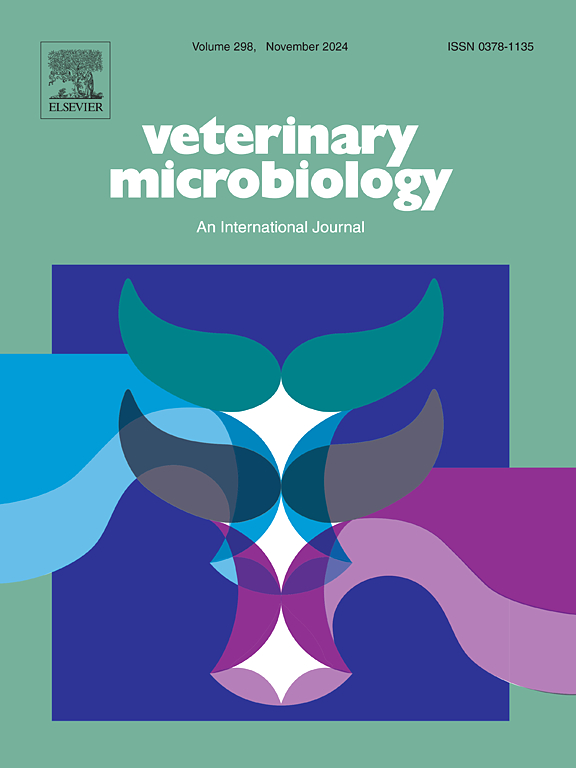Exploring the epidemiology and genetic complexity of Escherichia coli in vertically integrated pig production systems using whole genome sequencing
IF 2.4
2区 农林科学
Q3 MICROBIOLOGY
引用次数: 0
Abstract
Escherichia coli is a major pathogen responsible for enteric diseases in swine. This study aims to assess the genetic diversity, virulence factors, and antimicrobial resistance genes of E. coli isolated from diarrheic pigs within Spanish integrated production systems. Metadata, including epidemiological data and minimum inhibitory concentration (MIC), was collected for 350 clinical isolates reported to the laboratory between 2018 and 2022. MIC analysis using Ward’s hierarchical clustering identified 17 phenotypic resistance clusters. A subset of 206 isolates, representing different production pyramids and phenotypic clusters, was selected for whole genome sequencing (WGS). In silico serotyping and multilocus sequence typing revealed high genetic diversity, with predominant serotypes O138:H14, O147:H14, O141:H4, and O108:H39, and sequence types ST10 and ST42. Only three ST131 isolates were found in a single production pyramid suggesting that swine associated ST131 is not contributing significantly to the epidemiology of human infections associated to this ST. Isolates were classified into six phylogroups, with phylogroup A being the most represented. AMR profiling identified a high percentage of resistance (> 50 %) to tetracyclines, aminoglycosides, quinolones, trimethoprim and sulphonamides, while resistance to third-generation cephalosporins and colistin remained low (< 25 %). Comparative genomic analysis demonstrated high genetic diversity within production pyramids, although, some clones persisted over time, suggesting transmission within batches. Statistical analyses found no association between genetic traits and farm origins, although outbreaks often involved clones with minimal SNP differences. This study underscores the complexity of E. coli transmission in swine and highlights the need for genomic surveillance to monitor AMR.
利用全基因组测序技术探索垂直整合生猪生产系统中大肠杆菌的流行病学和遗传复杂性
大肠杆菌是猪肠道疾病的主要病原体。本研究旨在评估西班牙综合生产系统中从腹泻猪中分离的大肠杆菌的遗传多样性、毒力因子和抗微生物药物耐药性基因。收集了2018年至2022年间报告给实验室的350株临床分离株的流行病学数据和最低抑制浓度(MIC)等元数据。MIC分析使用Ward 's分层聚类鉴定出17个表型抗性聚类。选取了206株具有不同生产金字塔和表型簇的分离株进行全基因组测序(WGS)。血清分型和多位点序列分型显示出较高的遗传多样性,主要为O138:H14、O147:H14、O141:H4和O108:H39血清型,以及ST10和ST42序列型。在一个生产金字塔中只发现了三个ST131分离株,这表明猪相关的ST131对与该st相关的人类感染的流行病学没有显著贡献。分离株被分为6个系统群,其中a系统群最具代表性。AMR分析鉴定出高百分比的耐药性(>;50% %)对四环素类、氨基糖苷类、喹诺酮类、甲氧苄啶和磺胺类药物的耐药性,而对第三代头孢菌素和粘菌素的耐药性仍然很低(<;25 %)。比较基因组分析表明,在生产金字塔中具有较高的遗传多样性,尽管一些克隆随着时间的推移而持续存在,表明在批次内传播。统计分析发现遗传性状与农场起源之间没有关联,尽管疫情通常涉及SNP差异最小的克隆。这项研究强调了大肠杆菌在猪中传播的复杂性,并强调了对AMR进行基因组监测的必要性。
本文章由计算机程序翻译,如有差异,请以英文原文为准。
求助全文
约1分钟内获得全文
求助全文
来源期刊

Veterinary microbiology
农林科学-兽医学
CiteScore
5.90
自引率
6.10%
发文量
221
审稿时长
52 days
期刊介绍:
Veterinary Microbiology is concerned with microbial (bacterial, fungal, viral) diseases of domesticated vertebrate animals (livestock, companion animals, fur-bearing animals, game, poultry, fish) that supply food, other useful products or companionship. In addition, Microbial diseases of wild animals living in captivity, or as members of the feral fauna will also be considered if the infections are of interest because of their interrelation with humans (zoonoses) and/or domestic animals. Studies of antimicrobial resistance are also included, provided that the results represent a substantial advance in knowledge. Authors are strongly encouraged to read - prior to submission - the Editorials (''Scope or cope'' and ''Scope or cope II'') published previously in the journal. The Editors reserve the right to suggest submission to another journal for those papers which they feel would be more appropriate for consideration by that journal.
Original research papers of high quality and novelty on aspects of control, host response, molecular biology, pathogenesis, prevention, and treatment of microbial diseases of animals are published. Papers dealing primarily with immunology, epidemiology, molecular biology and antiviral or microbial agents will only be considered if they demonstrate a clear impact on a disease. Papers focusing solely on diagnostic techniques (such as another PCR protocol or ELISA) will not be published - focus should be on a microorganism and not on a particular technique. Papers only reporting microbial sequences, transcriptomics data, or proteomics data will not be considered unless the results represent a substantial advance in knowledge.
Drug trial papers will be considered if they have general application or significance. Papers on the identification of microorganisms will also be considered, but detailed taxonomic studies do not fall within the scope of the journal. Case reports will not be published, unless they have general application or contain novel aspects. Papers of geographically limited interest, which repeat what had been established elsewhere will not be considered. The readership of the journal is global.
 求助内容:
求助内容: 应助结果提醒方式:
应助结果提醒方式:


